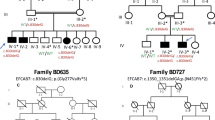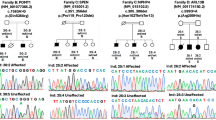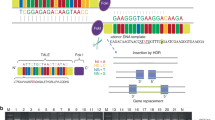Abstract
Polydactyly is characterized by an extra supernumerary digit/toe with or without bony element. To date variants in four genes GLI3, ZNF141, MIPOL1 and PITX1 have been implicated in developing non-syndromic form of polydactyly. The present study involved characterization of large consanguineous family of Pakistani origin segregating post-axial polydactyly type A, restricted to lower limb, in autosomal recessive pattern. DNA of two affected members in the family was subjected to exome sequencing. Sanger sequencing was then followed to validate segregation of the variants in the family members. A homozygous splice acceptor site variant (c.395-1G>A) was identified in the IQCE gene, which completely co-segregated with post-axial polydactyly phenotype within the family. The homozygous variant was absent in different public variant databases, 7000 in-house exomes, 130 exomes from unrelated Pakistani individuals and 215 ethnically matched controls. Mini-gene splicing assay was used to test effect of the variant on function of the gene. The assay revealed loss of first nucleotide of exon 6, producing a −1 frameshift and a premature stop codon 22 bases downstream of the variant (p.Gly132Valfs*22). The study provided the first evidence of involvement of the IQCE gene in limbs development in humans.
Similar content being viewed by others
Log in or create a free account to read this content
Gain free access to this article, as well as selected content from this journal and more on nature.com
or
References
Schwabe GC, Mundlos S : Genetics of congenital hand anomalies. Handchir Mikrochir Plast Chir 2004; 36: 85–97.
Christensen JC, Leff FB, Lepow GM et al: Congenital polydactyly and polymetatarsalia: classification, genetics, and surgical correction. J Foot Ankle Surg 2011; 50: 336–339.
Malik S : Polydactyly: phenotypes, genetics and classification. Clin Genet 2014; 85: 203–212.
Malik S, Ullah S, Afzal M, Lal K, Haque S : Clinical and descriptive genetic study of polydactyly: a Pakistani experience of 313 cases. Clin Genet 2014; 85: 482–486.
Biesecker LG : Polydactyly: how many disorders and how many genes? 2010 update. Develop Dyn 2011; 240: 931–942.
Deng H, Tan T, Yuan L : Advances in the molecular genetics of non-syndromic polydactyly. Expert Rev Mol Med 2015; 17: 1–10.
Talamillo A, Bastida MF, Fernandez-Teran M, Ros MA : The developing limb and the control of the number of digits. Clin Genet 2005; 67: 143–153.
Haber LL, Adams HB, Thompson GH, Duncan LS, Didomenico LA, McCluskey WP : Unique case of polydactyly and a new classification system. J Pediatr Orthop 2007; 27: 326–328.
Phadke SR, Sankar VH : Polydactyly and genes. Indian J Pediatr 2010; 77: 277–281.
Umm-e-Kalsoom, Basit S, Kamran-ul-Hassan Naqvi S, Ansar M, Ahmad W : Genetic mapping of an autosomal recessive postaxial polydactyly type A to chromosome 13q13.3-q21.2 and screening of the candidate genes. Hum Genet 2012; 131: 415–422.
Kalsoom UE, Klopocki E, Wasif N et al: Whole exome sequencing identified a novel zinc-finger gene ZNF141 associated with autosomal recessive postaxial polydactyly type A. J Med Genet 2012; 50: 47–53.
Reese MG, Eeckman FH, Kulp D, Haussler D : Improved splice site detection in Genie. J Comput Biol 1997; 4: 311–323.
Mort M, Sterne-Weiler T, Li B et al: MutPred Splice: machine learning-based prediction of exonic variants that disrupt splicing. Genome Biol 2014; 15: R19.
Woolfe A, Mullikin JC, Elnitski L : Genomic features defining exonic variants that modulate splicing. Genome Biol 2010; 11: R20.
Desmet FO, Hamroun D, Lalande M, Collod-Béroud G, Claustres M, Béroud C : Human Splicing Finder: an online bioinformatics tool to predict splicing signals. Nucleic Acids Res 2009; 37: e67.
Buckler AJ, Chang DD, Graw SL : Exon amplification: a strategy to isolate mammalian genes based on RNA splicing. Proc Natl Acad Sci USA 1991; 88: 4005–4009.
Haack TB, Danhauser K, Haberberger B et al: Exome sequencing identifies ACAD9 mutations as a cause of complex I deficiency. Nat Genet 2010; 42: 1131e4.
Zhao H, Tian Y, Breedveld G et al: Postaxial polydactyly type A/B (PAP-A/B) is linked to chromosome 19p13.1-13.2 in a Chinese kindred. Eur J Hum Genet 2002; 10: 162–166.
Galjaard RJ, van der Linde HC, Eussen BH et al: Isolated postaxial polydactyly type B with mosaicism of a submicroscopic unbalanced translocation leading to an extended phenotype in offspring. Am J Med Genet A 2003; 121A: 168–173.
Al-Qattan MM : A novel frameshift mutation of the GLI3 gene in a family with broad thumbs with/without big toes, postaxial polydactyly and variable syndactyly of the hands/feet. Clin Genet 2012; 82: 502–504.
Pusapati GV, Hughes CE, Dorn KV et al: EFCAB7 and IQCE regulate hedgehog signaling by tethering the EVC-EVC2 complex to the base of primary cilia. Dev Cell 2014; 28: 483–496.
Hansen GM, Markesich DC, Burnett MB et al: Large-scale gene trapping in C57BL/6 N mouse embryonic stem cells. Genome Res 2008; 18: 1670–1679.
Eppig JT, Blake JA, Bult CJ, Kadin JA, Richardson JE : The Mouse Genome Database Group. 2015. The Mouse Genome Database (MGD): facilitating mouse as a model for human biology and disease. Nucleic Acids Res 2015; 28: 43.
Blair HJ, Tompson S, Liu YN et al: Evc2 is a positive modulator of Hedgehog signalling that interacts with Evc at the cilia membrane and is also found in the nucleus. BMC Biol 2011; 9: 14.
Ruiz-Perez VL, Blair HJ, Rodriguez-Andres ME et al: Evc is a positive mediator of Ihh-regulated bone growth that localises at the base of chondrocyte cilia. Development 2007; 134: 2903–2912.
Caparrós-Martín JA, Valencia M, Reytor E et al: The ciliary Evc/Evc2 complex interacts with Smo and controls Hedgehog pathway activity in chondrocytes by regulating Sufu/Gli3 dissociation and Gli3 trafficking in primary cilia. Hum Mol Genet 2013; 22: 124–139.
Lopez-Rios J : The many lives of SHH in limb development and evolution. Semin Cell Dev Biol 2016; 49: 16–24.
Dorn KV, Hughes CE, Rohatgi R : A Smoothened-Evc2 complex transduces the Hedgehog signal at primary cilia. Dev Cell 2012; 23: 823–835.
Acknowledgements
We highly appreciate cooperation and participation of the family members in this study. Muhammad Umair and Khadim Shah were supported by International Research Support Initiative Program (IRSIP) and Indigenous PhD fellowship (HEC) and from Higher Education Commission (HEC), Islamabad, Pakistan. This work was funded by Pakistan Academy of Science (PAS) Islamabad, Pakistan to Wasim Ahamad.
Author information
Authors and Affiliations
Corresponding author
Ethics declarations
Competing interests
The authors declare no conflict of interest.
Additional information
Supplementary Information accompanies this paper on European Journal of Human Genetics website
Supplementary information
Rights and permissions
About this article
Cite this article
Umair, M., Shah, K., Alhaddad, B. et al. Exome sequencing revealed a splice site variant in the IQCE gene underlying post-axial polydactyly type A restricted to lower limb. Eur J Hum Genet 25, 960–965 (2017). https://doi.org/10.1038/ejhg.2017.83
Received:
Revised:
Accepted:
Published:
Issue date:
DOI: https://doi.org/10.1038/ejhg.2017.83
This article is cited by
-
Identification of truncated variants in GLI family zinc finger 3 (GLI3) associated with polydactyly
Journal of Orthopaedic Surgery and Research (2024)
-
A dominant missense variant within LMBR1 related to equine polydactyly
Communications Biology (2024)
-
Variants in EFCAB7 underlie nonsyndromic postaxial polydactyly
European Journal of Human Genetics (2023)
-
Pervasive occurrence of splice-site-creating mutations and their possible involvement in genetic disorders
npj Genomic Medicine (2022)
-
The molecular genetics of human appendicular skeleton
Molecular Genetics and Genomics (2022)



